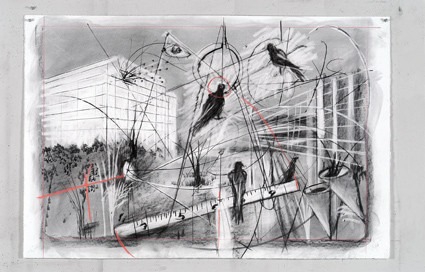William Kentridge
29 Jun - 05 Sep 2010

© 2010 William Kentridge
Drawing for the opera The Magic Flute, 2004–2005
Charcoal, pastel, and colored pencil on paper 120 x 160 cm
Collection of the artist, courtesy Marian Goodman Gallery, New York / Paris
photo: courtesy Marian Goodman Gallery, New York / Paris
Drawing for the opera The Magic Flute, 2004–2005
Charcoal, pastel, and colored pencil on paper 120 x 160 cm
Collection of the artist, courtesy Marian Goodman Gallery, New York / Paris
photo: courtesy Marian Goodman Gallery, New York / Paris
WILLIAM KENTRIDGE
"Five Themes"
from 29 June 2010 until 5 September 2010
Featuring about 40 works in a range of media —including animated films, drawings, prints, theater models, sculptures, and books— "William Kentridge: Five Themes" is co-organized by the San Francisco Museum of Modern Art and the Norton Museum of Art in West Palm Beach, Florida.
Curated by Mark Rosenthal, adjunct curator of modern art at the Norton Museum of Art, in close collaboration with the artist, the exhibition brings viewers up to date on the artist’s work over the past decade, exploring how his subject matter has evolved from the specific context of South Africa to more universal stories. In recent years, Kentridge has dramatically expanded both the scope of his projects (such as recent full-scale opera productions) and their thematic concerns, which now include his own studio practice, colonialism in Namibia and Ethiopia, and the cultural history of postrevolutionary Russia. His newer work is based on an intensive exploration of themes connected to his own life experience, as well as the political and social issues that most concern him.
Born in 1955 in Johannesburg, where he continues to live and work, Kentridge has earned international acclaim for his interdisciplinary practice, which often fuses drawing, film, and theater. He first gained recognition in 1997, when his work was included in Documenta X in Kassel, Germany, and in the Johannesburg and Havana Biennials, which were followed by prominent solo exhibitions internationally.
"William Kentridge: Five Themes" is organized by the San Francisco Museum of Modern Art and the Norton Museum of Art. Generous support for the exhibition is provided by the Koret Foundation. Additional support is provided by the National Endowment for the Arts.
"Five Themes"
from 29 June 2010 until 5 September 2010
Featuring about 40 works in a range of media —including animated films, drawings, prints, theater models, sculptures, and books— "William Kentridge: Five Themes" is co-organized by the San Francisco Museum of Modern Art and the Norton Museum of Art in West Palm Beach, Florida.
Curated by Mark Rosenthal, adjunct curator of modern art at the Norton Museum of Art, in close collaboration with the artist, the exhibition brings viewers up to date on the artist’s work over the past decade, exploring how his subject matter has evolved from the specific context of South Africa to more universal stories. In recent years, Kentridge has dramatically expanded both the scope of his projects (such as recent full-scale opera productions) and their thematic concerns, which now include his own studio practice, colonialism in Namibia and Ethiopia, and the cultural history of postrevolutionary Russia. His newer work is based on an intensive exploration of themes connected to his own life experience, as well as the political and social issues that most concern him.
Born in 1955 in Johannesburg, where he continues to live and work, Kentridge has earned international acclaim for his interdisciplinary practice, which often fuses drawing, film, and theater. He first gained recognition in 1997, when his work was included in Documenta X in Kassel, Germany, and in the Johannesburg and Havana Biennials, which were followed by prominent solo exhibitions internationally.
"William Kentridge: Five Themes" is organized by the San Francisco Museum of Modern Art and the Norton Museum of Art. Generous support for the exhibition is provided by the Koret Foundation. Additional support is provided by the National Endowment for the Arts.
